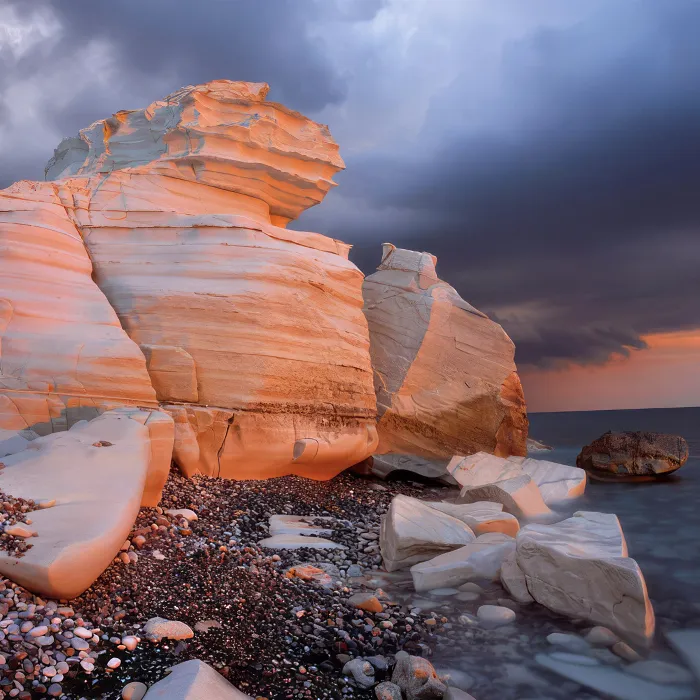The "Schuechter Hermann" in his workshop. The only additional lighting was a small video light on the right-hand side of the table. I deliberately chose the wide angle for this shot in order to include the surroundings.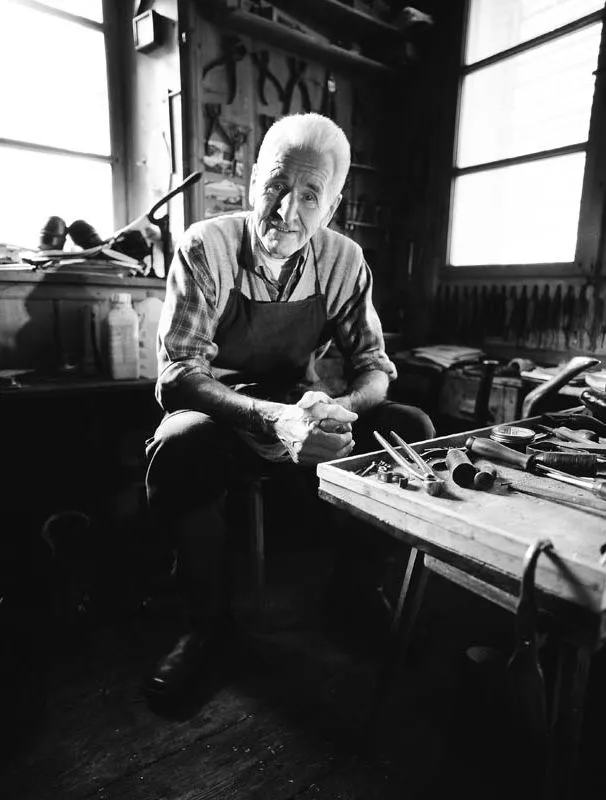
Contax 645, Planar T f3.5 35 mm, Blender 3.5, 1/45 second, Fuji Velvia 100, pushed to ISO 200.
I've been sitting opposite "Schuechter Hermann" for two hours. I tell him about my exhibition project "Faces from the mountains". I would also like to portray him, just like many other people from the Ötztal. They are all somewhere between 70 and 100 years old and have one thing in common: an unusual and intense life in the mountains.
We talk a lot, again about ski tours and the bad snow at the moment. He is in his mid-seventies and still tours the mountains almost every day. In between, he works in his shoemaker's workshop in Dorf near Längenfeld, just like his father and grandfather. His workshop is simply incredible: the photogenic grazing light, the old tools, the saddler's sewing machine, plus Hermann. As if time had simply stood still in this room. Again and again, I steer the conversation towards my photography and the exhibition.
I hope for a sign from him, for his words of approval. Can I even take a few pictures of him? The medium format camera lies next to me, along with various magazines with black and white and slide film. After four hours he says in his Ötztal dialect: "mei da must holt in a paar Tagnen widar a moi kemmen". He is tired and wants to rest. A little sad and frustrated, I step out into the cold winter air.
In the end, however, I am quite happy about his decision; the time is not yet ripe for the pictures I am hoping for. A few days later, I'm sitting with him again, drinking tea and talking about God and the world. But this time, too, the camera remains untouched. It wasn't until the third visit that the "chemistry" between us was right. Now we have something in common, especially through the long conversations about our mutual passion, the mountains.
He then spontaneously asks: "Yes, when are you finally going to take your pictures?" I am infinitely grateful for these words, grateful for the photos, but above all grateful for the wonderful hours with him. He was full of joy and pride when he witnessed the opening of the exhibition. Hermann passed away a few months later.
Frieda and Friedl Kneisl spent their entire lives on the Grubealm near Sölden. The photo was taken without any additional lighting on the terrace of their alpine pasture.
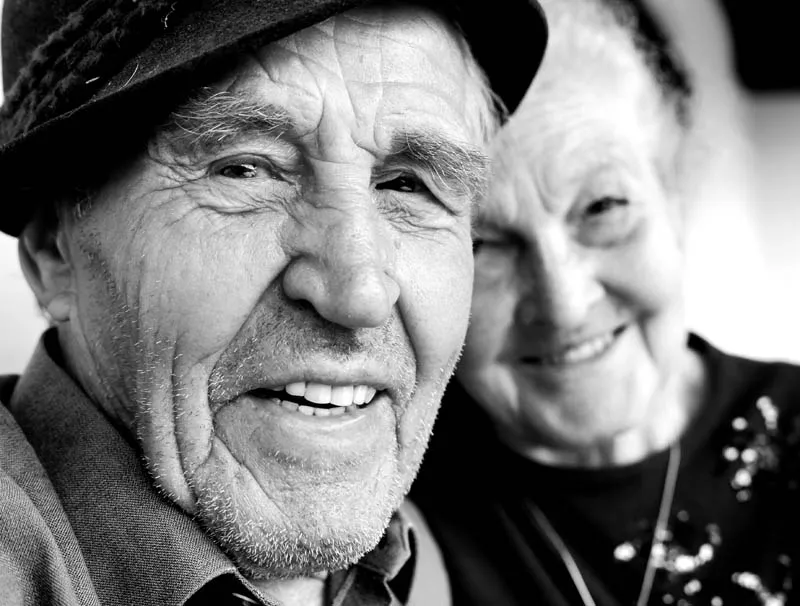
Contax 645, Planar T f2 80 mm, Blender 8, 1/30 second, Fuji Velvia 100.
In my eyes, portraiture and reportage are the most sensitive areas of photography. It's about ethics and respect. In hindsight, I'm more grateful than ever that I didn't take him by surprise or rush him. Good pictures take time and time is our most valuable asset. We also give our counterpart something of ourselves. Expressive portraits show the "mood", the "wire", the benevolent consent of the person portrayed.
That's why the first tips below are not tips, but interpersonal and ethical necessities:
- Give your counterpart time, seek conversation, get to know each other. With Hermann, this process took three days!
- Maintain a certain level of respect, a minimum distance.
- Feel when it's time to stop taking photos. The shoots for "Faces from the mountains" only took about five to ten minutes for all 25 people!
- Present the portrait subjects with beautiful prints.
Incidentally, this also applies if we know the person we are photographing!
I have deliberately chosen only pictures from a single portrait production for this tutorial. They were created from a single source and, above all, with little technical effort, but still give me the opportunity to explore different lighting situations and techniques. They were created within six months in the Tyrolean Ötztal.
This is also reportage: hands sometimes say more than a thousand words. The light from the left comes from a discreet video light.
Contax 645, Planar T f2 80 mm, Blender 2.4, 1/30 second, Fuji Velvia 100, pushed to ISO 200.
The camera
In principle, you can take portraits with all cameras. With compact cameras or viewfinder cameras, however, the creative possibilities and the exact control of the all-important depth of field are very limited. Due to the extremely short focal lengths of digital compact cameras, it is also almost impossible to take photos with a soft blur (the so-called bokeh) in the background.
The only exception here is the Leica "M" system (or similar). SLR cameras are also ideal and standard in this area of photography. Here we have a large selection of accessories (lenses, flashes etc.) at our disposal. In addition, almost all of them now have a fast motor so as not to miss the "right moment".
A camera with a stop-down button is useful for controlling the extent of the depth of field and the "bokeh" in the out-of-focus area. In this area of photography, shooting with aperture priority is particularly useful and helpful for controlling the extent of the depth of field in the face or room.
The following basic settings on the camera are my technical standard here:
- The RAW format, among other things, to precisely control the drawing in highlights and shadows.
- Automatic white balance, because it produces the best results in different lighting situations and light sources, especially when things have to be done quickly (the color temperature can also be corrected later in RAW files).
- Flashing on the second shutter curtain.
The light again comes from the left from a video light. The sacristan Andrä Scheiber in "his" church in Umhausen. The wide-angle lens makes it possible to include the surroundings, but the hands in the foreground become quite dominant.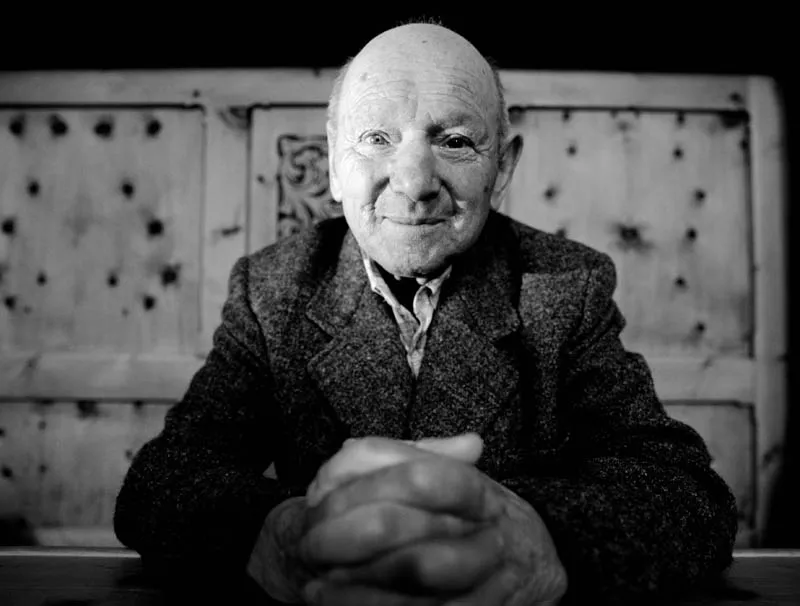
Contax 645, Planar T f3.5 35 mm, Blender 4, 1/45 second, Fuji Velvia 100, pushed to ISO 200.
The lens
Of course you can photograph portraits with all focal lengths and lenses. However, the results will be quite different. Distorted faces or unnatural proportions are the result of extreme focal lengths (e.g. too wide an angle!!). The so-called portrait focal lengths between 85 mm and 135 mm are ideal. But the 50 mm normal focal length or stronger telephoto lenses up to 300 mm are also quite suitable. Precise autofocus is important.
Nothing is worse than supposedly focusing on your eyes and then discovering the focus on the tip of your nose days later on the screen.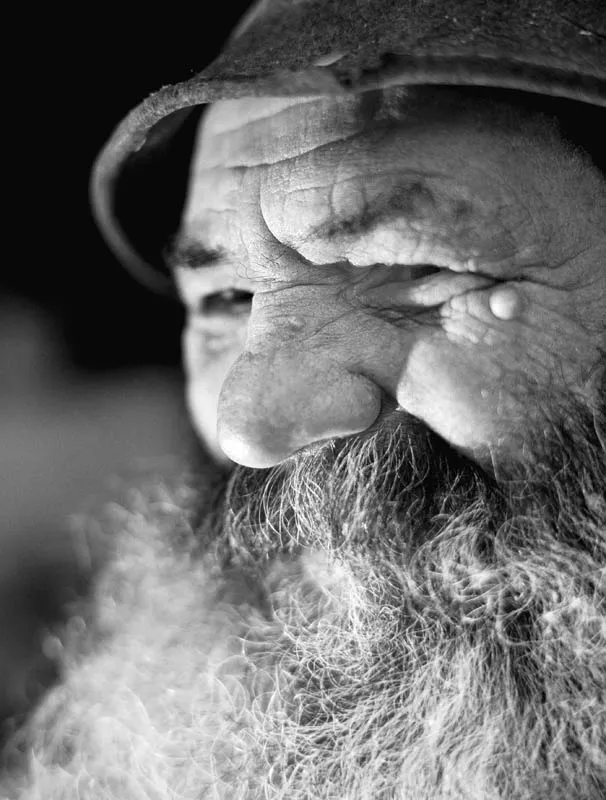
Contax 645, Planar T f2 80 mm, Blender 4, 1/45 second, Fuji Velvia 100, pushed to ISO 200.
Karl Sonnweber from Habichen in his workshop. Two lamps were used here: a strong one from the left (LED) for a backlight effect and a much weaker one from the right to brighten the shadows.
It is therefore essential to test the lenses beforehand and, if necessary, have them adjusted by the manufacturer together with the camera. I prefer to shoot portraits with fast fixed focal lengths in order to distribute the blur really sensitively and, above all, "as soft as butter". The old mechanical lenses (e.g. from Leica or Zeiss), which can be used on many common SLR cameras using an adapter, are still very suitable here. Their advantage: the wide distance adjustment rings run very precisely and without play and therefore enable perfect focusing. By closing the Blender manually (the so-called working aperture), you can always keep an eye on the expansion of the depth of field during photography with mechanical/manual lenses. These old high-quality lenses in particular produce a wonderful "bokeh". Please consider the following with regard to lenses: A "monster 400 mm lens" can have a frightening effect on many people. My experience is that we often take the more natural pictures with inconspicuous, small equipment.
Contax 645, Planar T f2 80 mm, Blender 2.8, 1/125 second, Fuji Velvia 100, pushed to ISO 200.
Burgl Ribis looks out of her window in Obergurgl. The available light from the overcast sky was sufficient for this shot.
Additional light: flash unit - flash - video light - power LED
In my opinion, photo magazines talk far too often and intensively about flash systems, their possibilities and their professional image. In all my portrait productions, I have never once used my flash system.
I now much prefer to work with discreet, easily dosed and controllable continuous light. Regardless of whether it's a video light with a battery or LED lights, I "see" their light, am quick and flexible and don't unsettle my subject with a mass of intrusive technology.
Most of the shots in this tutorial would certainly not have been possible if I had spent an hour setting up the generator, tripods, cables, softboxes etc. each time! Conclusion: Nobody needs to spend 2000 euros on a flash system to take good photos!
Nannele Klotz lives high above the Ötztal in Oetzerberg. Eight children, 12 grandchildren and farming keep her fit. I brightened up her face a little with a discreet video light.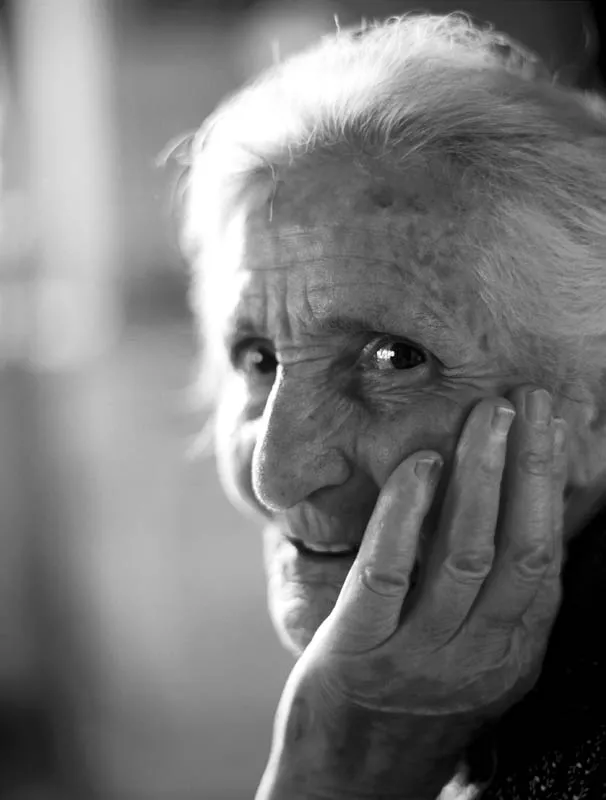
Contax 645, Planar T f2 80 mm, Blender 2.4, 1/30 second, Fuji Velvia 100, pushed to ISO 200.
What lighting equipment do I have with me?
On portrait productions like the one in Ötztal, for example, I have two video lights with 35 watts each, including a spare battery. (Simple versions are available from as little as 40 euros, e.g. from Kaiser or Canon, but professional lamps such as those from Dedolight can quickly cost over 300 euros).
In addition, an LED lamp (dimmable if possible) and a clip-on flash with an untethered cable so that the flash can be positioned to the side of the camera. For outdoor shots, a brightener from California Sunbounce.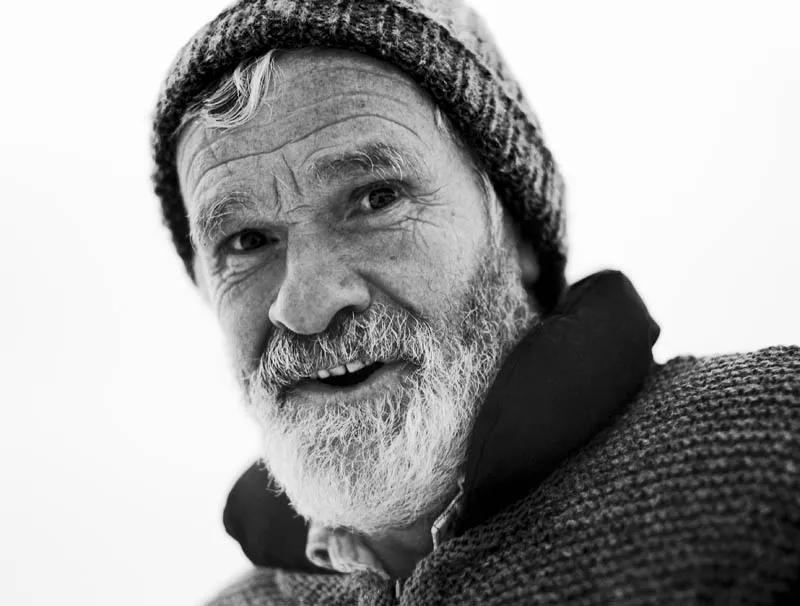
Contax 645, Planar T f2 80 mm, Blender 5.6, 1/60 second, Fuji Velvia 100.
Meinhard Strobl is the weather expert of the Ötztal. For this shot in front of his house in Obergurgl, only the snow on the ground served as a "natural" brightener.
How do I use my light and above all: when do I use which light?
What are the differences? I use the flash when things have to happen quickly, for example when the person is moving and I often change position or location. I have a plastic cap on the flash (STO-FEN from Omnibounce) and a filter foil underneath (e.g. from Lee) to make my light "warmer". In interiors with a mixture of different light bulbs and neon light, the color temperature is often around 3000 Kelvin. The flash light (= cold daylight) would "shine out" here as unnaturally cold.
I usually have to reduce the power of the flash (at least with Canon) in order to maintain a natural image impression. If the ceiling in the room is white, I sometimes point the flash vertically upwards. The light reflected from the ceiling is often more pleasant because it is more indirect than the direct light from the flash.
The light from the LED lamp is very directional and I usually use it as a direct spotlight to create a strong accent on a person's face or in the background of the room. I usually position it somewhere fixed in the room, e.g. on a shelf, on a cupboard or similar. I also sometimes fix a filter foil (with tape or rubber) in front of the LED lamp to adjust the color temperature.
The light from the video lights is very pleasant and usually has a similar color temperature to most light bulbs in rooms. Their only drawback: the battery power is moderate compared to LED lamps, which means you have to be economical with them and only use them very selectively during the shoot.
What to do if the light is too strong and the lamp cannot be dimmed? The trick with the Tempo handkerchief is very simple and, above all, cheap. You separate it into its individual layers and attach them in front of the lamp. The more layers, the less light gets through.
The old kitchen of the Farst snack station is a photographic gem. Sabina Falkner cooking.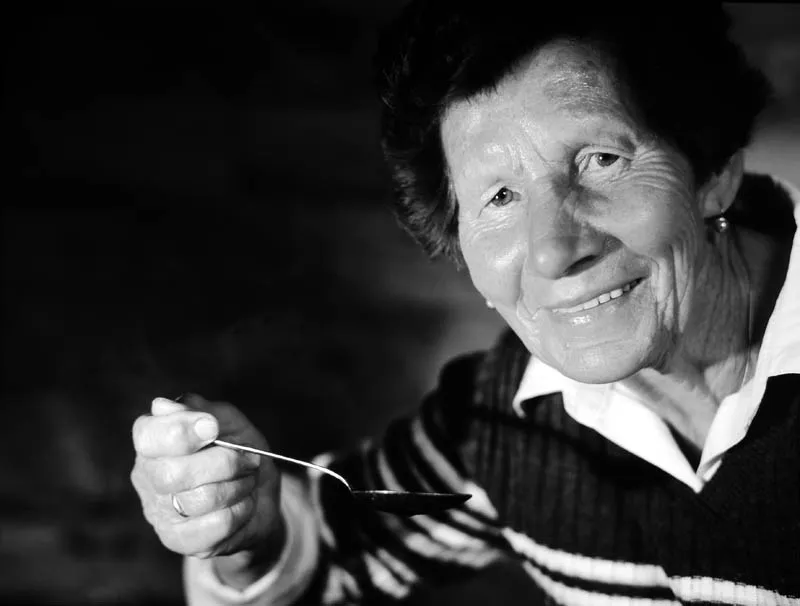
Contax 645, Planar T f2 80 mm, Blender 3.5, 1/60 second, Fuji Velvia 100, pushed to ISO 200.
Portrait photography - close - intimate - expressive
- How does an indoor portrait shoot work?
As described above, I give the person a lot of time. We get to know each other through long conversations. At the same time, however, I also observe the room and think about which background to choose, which section, which focal length and - very importantly - whether I need additional lighting and, if so, where to place it.
As soon as the set-up is in place, I try to keep the person as relaxed as possible through further conversations. In doing so, I always try to change the person's facial expressions and posture. Finally, I focus as precisely as possible on the eyes and then stop down by one or two Blenders. With the f1.8-85 mm lens, this means that I shoot with an aperture of 2.8 or 4, for example. Always depending on the background, of course!
Then you're ready to go. Whenever I think a moment is photogenic, I pull the trigger. Usually several times in succession to capture even the finest differences in the view. I regularly check the extension of the depth of field using the stop-down button.
An essential principle of my portrait photography is not to overtax the subjects. "Sessions" lasting several hours make absolutely no sense in my eyes. Much more important is meticulous preparation in terms of location and light.
The following three pictures are about a person's gaze and the detail of a scene. In this first shot, Annemarie Ennemoser is just smiling - which I think is very nice! Two lamps were used as the light source: an LED light from the left and a video light from the right. The left light creates a nice backlight effect.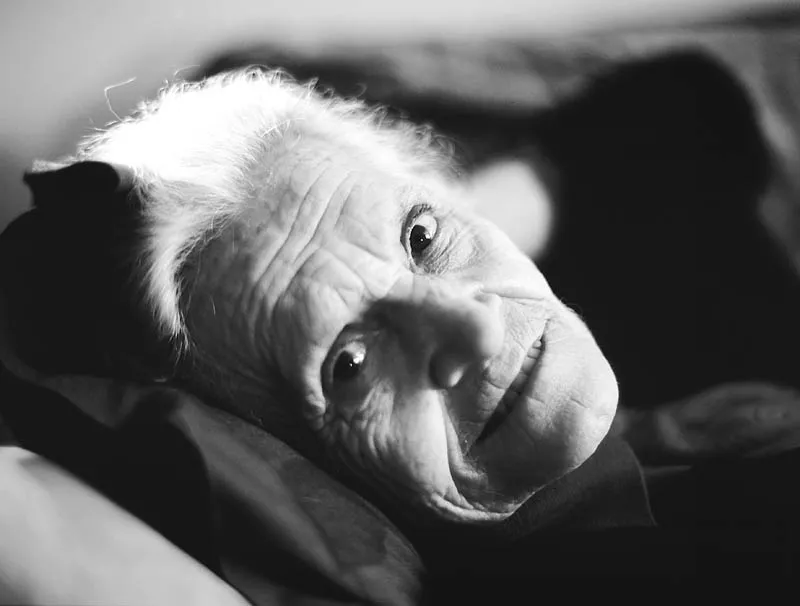
Contax 645, Planar T f2 80 mm, Blender 2, 1/30 second, Fuji Velvia 100, pushed to ISO 200.
A second later, her grin turned into a big laugh. Which shot is the better one remains a matter of taste in my eyes.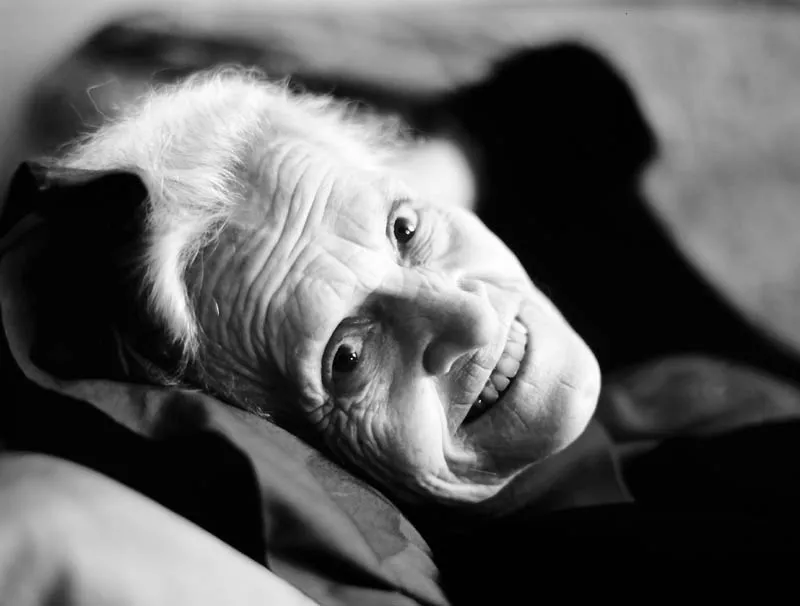
Contax 645, Planar T f2 80 mm, Blender 2, 1/30 second, Fuji Velvia 100, pushed to ISO 200.
For this third shot, I simply took a step back. The result was a completely new perspective showing the surroundings.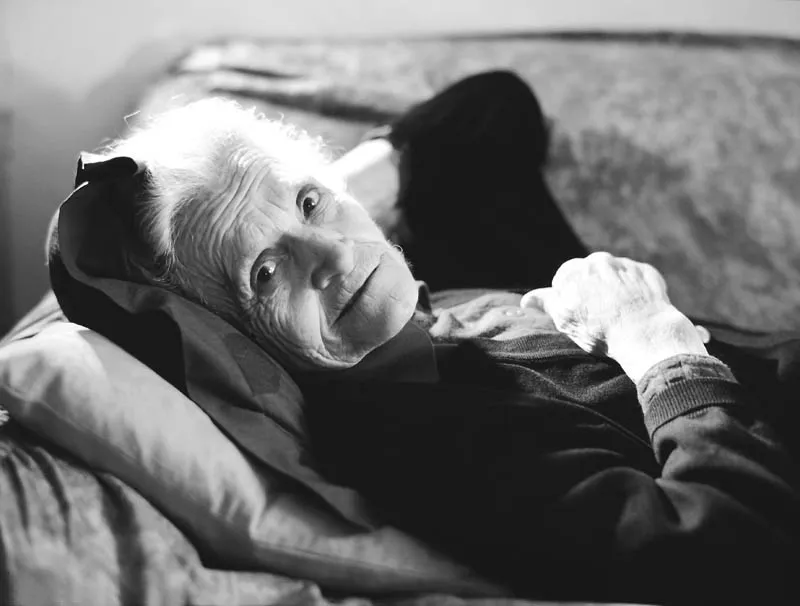
Contax 645, Planar T f2 80 mm, Blender 2.8, 1/30 second, Fuji Velvia 100, pushed to ISO 200.
2 How does a portrait shoot in nature work?
The basic approach is the same as indoors. However, there is a major technical difference in the light. Direct sunlight, especially when the sun is high in the sky, is sometimes too harsh for sensitive portraits.
Many photographers prefer the even light of an overcast sky. If necessary, I therefore position the person in the shade and use a brightener (e.g. from California Sunbounce) to create a soft brightening light (a helper is of course worth its weight in gold!!) But I also prefer to use brighteners in backlit situations, which conjure up an appealing fringe of light in the hair, to brighten up the shadowy face.
I have had the best experience with the so-called "zebra structure" (gold/silver stripes). However, when the sun is low, portraits in direct sunlight also have a certain appeal.
Due to the low sun, the shadows on the face of mountain guide Hubert Scheiber from Vent are not yet too harsh. I used a very small amount of brightener to bring some light to the eyes.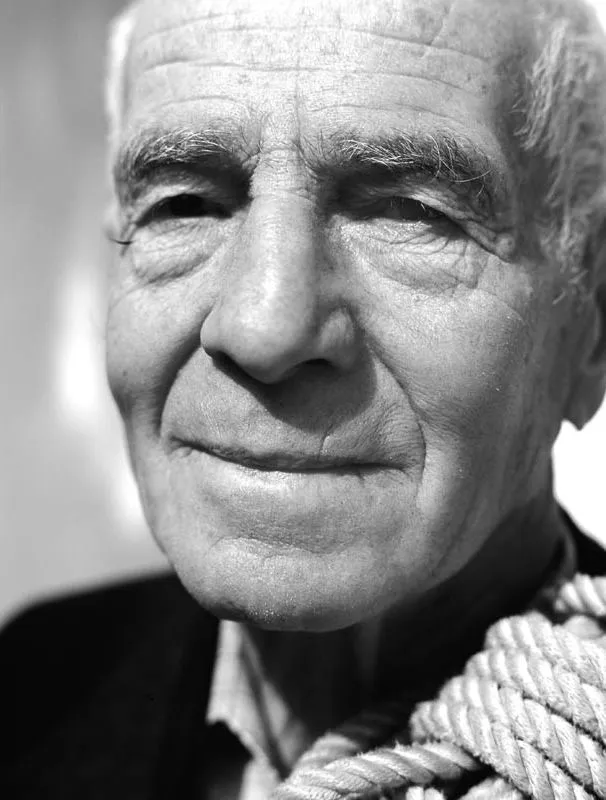
Contax 645, Planar T f2 80 mm, Blender 5.6, 1/250 second, Fuji Velvia 100.
What does it actually feel like to be photographed? Very few photographers know ... So my final tip is to let yourself be photographed and "feel" what it feels like to sit in front of a camera.
I wish you lots of fun behind the camera, but also respect and empathy for the people in front of the camera.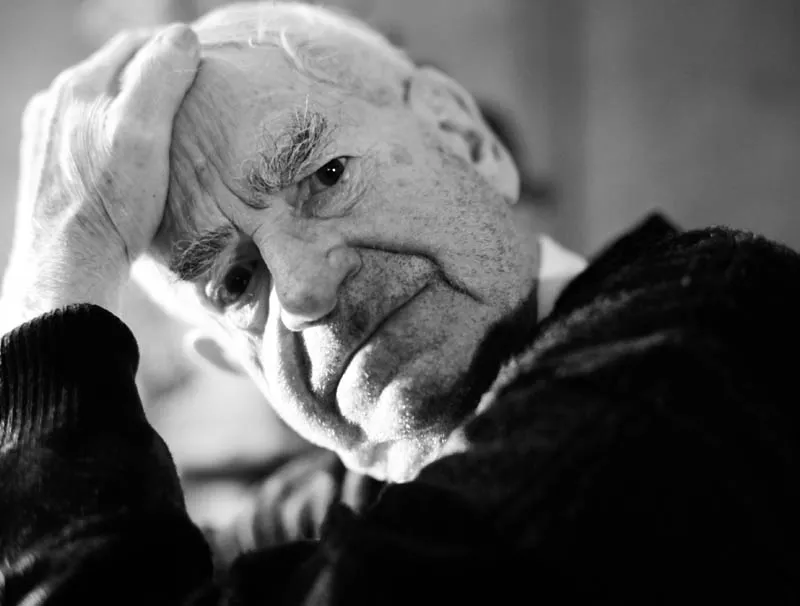
Contax 645, Planar T f2 80 mm, Blender 2.8, 1/20 second, Fuji Velvia 100, pushed to ISO 200.
Engelbert Kuen in his parlor in Längenfeld. The LED lamp from the left provided the main light through the arm, the weak lamp from the right brightened the shadows a little.
